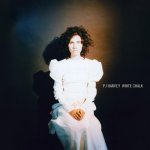
PJ Harvey White Chalk
(Island)
Removing herself, at least in the studio, from the guitar-based, modern sounds of her past recordings, PJ Harvey's eighth record, White Chalk, uses pseudo-Victorian elements - drama, restraint, and antiquated instruments and sounds - to capture a deliberate collection of eleven tense, eerie songs.
High Victorian art was successful when exposing individuals living within the claustrophobic elements of the middle and upper classes of Europe. This album fits in nicely to this niche - it is a rustic, speculative, looking-out-at-the-sea kind of listen, far removed from the acidic, raw thrash of much of Harvey's work in the past.
On the cover she is draped in a lacy, shoulder-puffed dress, hands crossed in her lap like a nun. She sits against a black wall. Period instruments such as the zither, broken harp, cig fiddle, concertina, and banjo are played by her, John Parish, Eric Drew Feldman and Jim White (of the Dirty Three). We listen through many dramatic flashes, flairs of piano and acoustic guitar, and expectant pauses. The sounds can be somber and spooky, like on the devilish Broken Harp, an album highlight. She sings of relationships, of an unborn child, of disappointment, of a grandmother.
Much has been made of the predominance of piano - rather than guitar - as the lead instrument on White Chalk. Polly Jean learnt to play the instrument for this record; some of the songs are a novel take on the piano, while others, such as the first single, When Under Ether, or the fantastic The Piano, are cut from the same brand of songwriting most of us are familiar with from Harvey.
The production and sound of the record, handled by Flood and Parish alongside Harvey, is equally important to the presentation. The audio backdrop on Harvey's records, though, has always been the canvas for her voice. On this album, she has shifted her voice higher in register. Somehow, this brings to mind metaphors of ghosts and apparitions. At times it's as if she's forcing her voice - so overwhelming and heart pounding in the past - to creep into the corners of the room, but even up a few notches, she is still under control, creating demanding emotional spaces that few other singers can match for impact and originality.
Harvey's audio experiments are celebrated with the release of each new album. But I wonder what she would do without any limitations. She obviously has an expansive musical mind, but what if she escaped from the blues-based plot of verse-chorus? What if, like Diamanda Galas, a singer who takes the blues idiom as a takeoff point only to shred it to pieces, Harvey truly took herself out of her comfort zone? What then? She has made eight albums of songs. How much further could PJ, the Queen of Pain, stretch herself?
25 October, 2007 - 16:26 — Craig Thompson